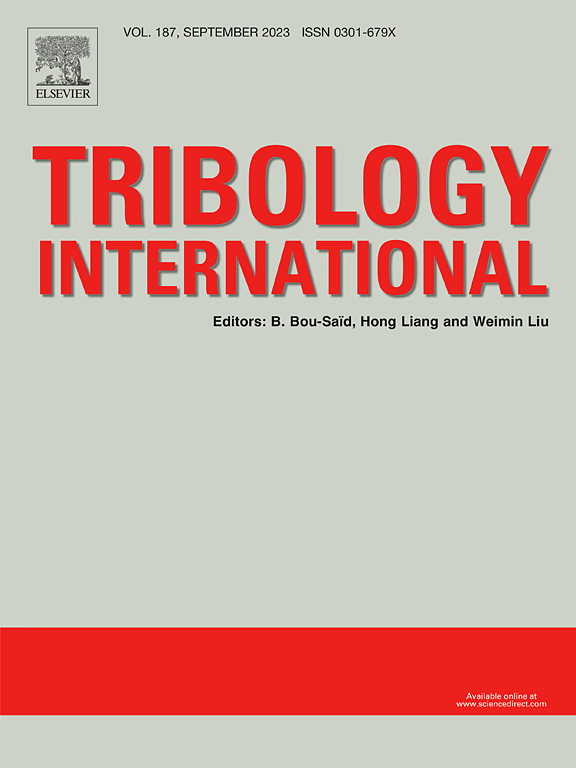Erosion behavior of Ti-hBN multifunctional coatings in a custom-made planetary test rig at extreme lunar temperatures
IF 6.1
1区 工程技术
Q1 ENGINEERING, MECHANICAL
引用次数: 0
Abstract
Spacecraft landings and takeoffs on the lunar surface, along with extreme temperature variations between day and night (−196 to 150º C), cause high-velocity dust impacts and erosion, resulting in the premature failure of structures. Ti/2 vol% hBN coatings were deposited using atmospheric (APS) and vacuum plasma spray (VPS) using cryo-milled powder feedstock to protect the structural components. The erosion performance of coatings at extreme lunar temperature regimes (−150 to 150 °C) was evaluated in a custom-made planetary erosion test rig (PETR) at low (50 mph) and high impact velocities (250 mph). The mass loss of VPS coatings was reduced by 50 % compared to the APS coatings and 40 % compared to the Ti6Al4V substrate. The cryogenic temperature induces brittleness in the material, rendering it susceptible to extreme conditions of material loss. The particle impact-deformation behavior was captured using a high-speed camera to study the erosion mechanism. This analysis revealed chipping in substrates and brittle APS coatings, while particles rebounding and embedding were observed in VPS coatings. Energy calculations, aided by particle trajectory tracking from the high-speed camera, have conclusively shown that VPS coatings absorb 5–10 % more energy than APS coatings during erosion tests. A modified erosion index was developed incorporating the fracture toughness and temperatures. New erosion models for brittle and ductile target materials are proposed for developing erosion-resistant material systems.
Ti-hBN 多功能涂层在极端月球温度下的定制行星试验台中的侵蚀行为
航天器在月球表面的着陆和起飞,以及昼夜之间极端的温度变化(-196 至 150ºC),会造成高速尘埃撞击和侵蚀,从而导致结构过早失效。使用低温研磨粉末原料,通过大气(APS)和真空等离子喷涂(VPS)沉积了 Ti/2 vol% hBN 涂层,以保护结构部件。在一个定制的行星侵蚀试验台(PETR)上,以低冲击速度(每小时 50 英里)和高冲击速度(每小时 250 英里)评估了涂层在极端月球温度下(-150 至 150 °C)的侵蚀性能。与 APS 涂层相比,VPS 涂层的质量损失减少了 50%,与 Ti6Al4V 基材相比,减少了 40%。低温导致材料脆化,使其容易在极端条件下发生材料损耗。使用高速摄像机捕捉颗粒的冲击变形行为,以研究侵蚀机制。分析结果表明,基底和脆性 APS 涂层出现崩裂,而在 VPS 涂层中观察到颗粒反弹和嵌入。在高速摄像机对颗粒轨迹跟踪的辅助下进行的能量计算最终表明,在侵蚀测试过程中,VPS 涂层比 APS 涂层多吸收 5-10% 的能量。结合断裂韧性和温度,开发了一种修正的侵蚀指数。为开发抗侵蚀材料系统提出了脆性和韧性目标材料的新侵蚀模型。
本文章由计算机程序翻译,如有差异,请以英文原文为准。
求助全文
约1分钟内获得全文
求助全文
来源期刊

Tribology International
工程技术-工程:机械
CiteScore
10.10
自引率
16.10%
发文量
627
审稿时长
35 days
期刊介绍:
Tribology is the science of rubbing surfaces and contributes to every facet of our everyday life, from live cell friction to engine lubrication and seismology. As such tribology is truly multidisciplinary and this extraordinary breadth of scientific interest is reflected in the scope of Tribology International.
Tribology International seeks to publish original research papers of the highest scientific quality to provide an archival resource for scientists from all backgrounds. Written contributions are invited reporting experimental and modelling studies both in established areas of tribology and emerging fields. Scientific topics include the physics or chemistry of tribo-surfaces, bio-tribology, surface engineering and materials, contact mechanics, nano-tribology, lubricants and hydrodynamic lubrication.
 求助内容:
求助内容: 应助结果提醒方式:
应助结果提醒方式:


